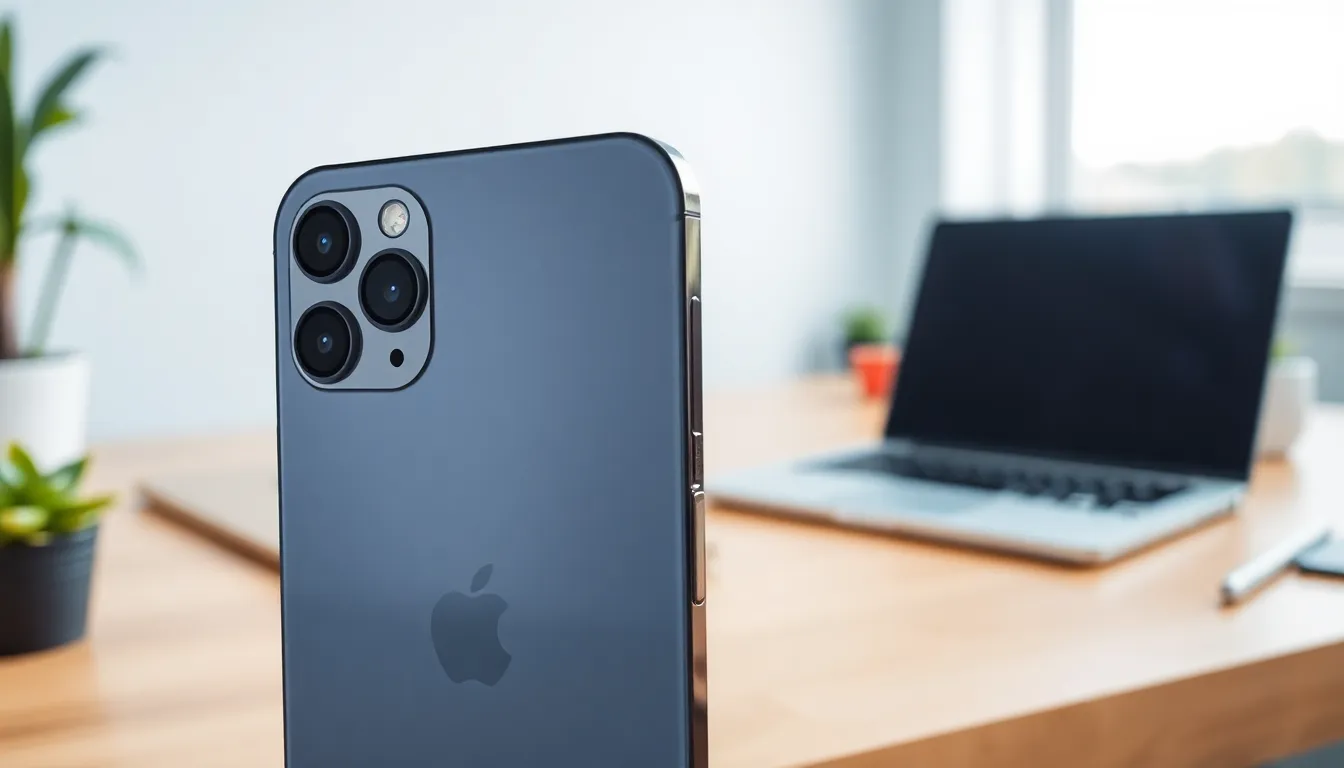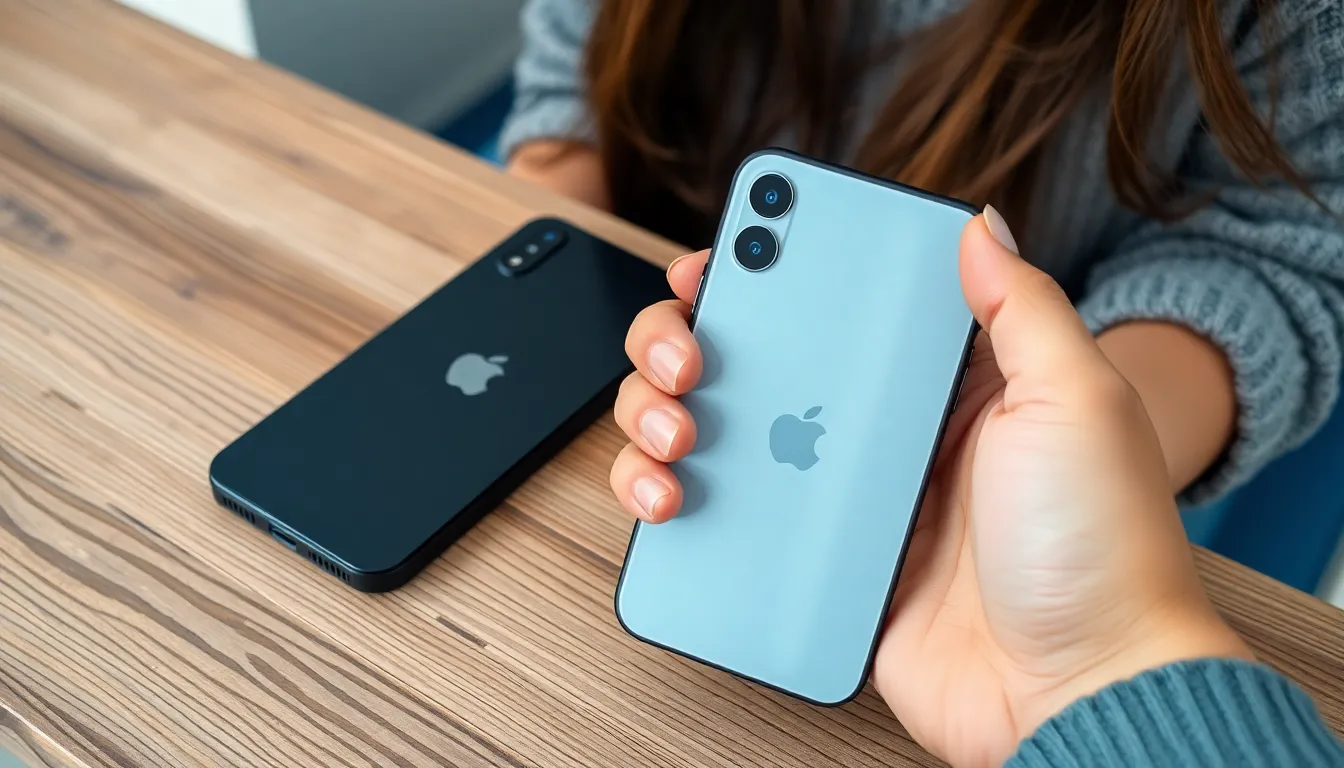When it comes to smartphones, Apple knows how to keep everyone buzzing. The iPhone 13 and iPhone 14 might look like twins at a glance, but dig a little deeper and you’ll find they’re more like distant cousins with some quirky differences. If you’ve ever wondered whether it’s worth upgrading or just sticking with your trusty iPhone 13, you’re not alone.
In a world where technology evolves faster than a cat meme goes viral, knowing the ins and outs of these devices can save you from a case of buyer’s remorse. From camera upgrades to battery life improvements, the distinctions could make all the difference in your daily life. So buckle up as we dive into the fascinating world of iPhones and uncover what sets the 13 and 14 apart.
Table of Contents
ToggleDesign Differences
The iPhone 13 and iPhone 14 exhibit noticeable design differences that reflect their updated technology. Both models showcase Apple’s sleek aesthetics, yet subtle enhancements exist.
Size and Weight
The dimensions of the iPhone 14 slightly differ from those of the iPhone 13. The iPhone 14 measures 5.78 inches in height, 2.82 inches in width, and 0.31 inches in depth, while the iPhone 13 is also 5.78 inches tall and 2.82 inches wide but a bit thicker at 0.30 inches. Weight also varies; the iPhone 14 weighs approximately 172 grams compared to the 174 grams of the iPhone 13. These minor adjustments make the iPhone 14 feel marginally different in hand, contributing to user experience.
Color Options
Color selection distinguishes the two models, offering users varied aesthetic choices. The iPhone 13 comes in six colors: pink, blue, midnight, starlight, red, and green. In contrast, the iPhone 14 introduces deeper hues, including new colors like blue, purple, midnight, starlight, red, and a striking new pink. These updates provide users with a wider palette, appealing to diverse preferences and styles.
Performance Upgrades

Performance improvements in the iPhone 14 provide a significant advantage over the iPhone 13. Enhanced processing efficiency leads to a smoother user experience.
Processor Comparison
The iPhone 14 features the A16 Bionic chip, which plays a crucial role in delivering faster performance and better energy efficiency. It outperforms the A15 Bionic chip found in the iPhone 13. With improved graphics capabilities, users experience smoother gameplay and enhanced photo editing features. Its machine learning capabilities allow for advanced computational photography, significantly improving image quality and processing speed during tasks like facial recognition and image stabilization.
RAM and Storage Options
The iPhone 14 comes equipped with 6 GB of RAM, enhancing multitasking capabilities compared to the 4 GB in the iPhone 13. This increase means smoother operation when running multiple apps simultaneously. Storage options also vary, with the iPhone 14 offering 128 GB, 256 GB, and 512 GB choices. The iPhone 13 provides similar storage options, but the iPhone 14 includes an additional 512 GB tier for users needing more space for apps, media, and files.
Camera Enhancements
The iPhone 14 includes significant camera enhancements compared to the iPhone 13. Upgrades improve photo quality, offering users a more robust photography experience.
Photo Quality
Larger sensors in the iPhone 14 capture more light, resulting in brighter images and less noise. Enhanced computational photography features enable improved low-light performance for nighttime shots. Portrait mode benefits from better edge detection, while Smart HDR 4 provides even richer details and vibrant colors. This combines to create images that stand out and feel lifelike.
Video Recording Features
Video recording on the iPhone 14 showcases advancements like Action mode, which stabilizes footage for smoother results. Cinematic mode now supports 4K recording at 30 fps and 24 fps, enhancing the storytelling aspect of videos. Users can also explore improved stabilization techniques that ensure professional-looking results. Enhanced low-light performance for video recording allows for capturing spectacular scenes even in dim settings.
Battery Life
Battery life varies between the iPhone 13 and iPhone 14, reflecting enhancements made in the newer model. Users can expect improved longevity from the iPhone 14.
Capacity and Efficiency
The iPhone 14 features a battery capacity of 3279 mAh, while the iPhone 13 has a capacity of 3240 mAh. This slight increase enhances the overall efficiency of the iPhone 14, allowing for longer usage times. Apple’s optimization techniques, in combination with the A16 Bionic chip, ensure energy consumption remains low. Users benefit from up to 20 hours of video playback on the iPhone 14, compared to 19 hours on the iPhone 13, representing a noticeable improvement in daily functionality.
Charging Speeds
Charging speeds differ significantly between the two models. The iPhone 13 supports 20W fast charging, providing a quick top-up experience. On the other hand, the iPhone 14 also supports 20W fast charging but is designed to integrate better with wireless charging solutions. Users can charge the iPhone 14 to about 50% in around 30 minutes with the right adapter. This increased efficiency, coupled with support for MagSafe accessories, enhances the overall charging convenience for users.
Software Features
The iPhone 13 and 14 run on iOS, but the iPhone 14 benefits from newer updates and features that enhance user experience.
iOS Versions
iPhone 14 ships with iOS 16, offering users the latest improvements and security updates. Features like customizable lock screens and enhanced notifications create a more personalized experience. In contrast, the iPhone 13 initially runs on iOS 15, although it can be updated to iOS 16. Users accessing iOS 16 on the iPhone 13 might miss out on optimized performance aspects uniquely available to the iPhone 14.
New Features in iPhone 14
Notable software features in the iPhone 14 include Emergency SOS via satellite and Crash Detection. These advancements enhance safety by providing help in remote areas or detecting severe accidents. Additionally, the iPhone 14 introduces a Photonic Engine for improved image processing. Such enhancements result in superior photography across all lighting conditions. The iPhone 13 lacks these features, which limits its capabilities in these specific contexts.
Price Comparison
Understanding the price difference between the iPhone 13 and iPhone 14 is crucial for potential buyers. Several factors influence these prices, including specifications and market demand.
Launch Prices
Launched at different price points, the iPhone 14 started at $799, while the iPhone 13 had a base price of $699. The price increase reflects the enhancements in technology and features in the iPhone 14, such as improved performance and camera capabilities. Both models offered various storage options, which also affected pricing. For example, higher storage tiers in the iPhone 14 further contributed to its overall cost compared to the iPhone 13.
Current Market Prices
Current market prices vary based on storage configurations and promotions. As of October 2023, the iPhone 13 typically ranges from $499 to $599 for refurbished or new models, whereas the iPhone 14 falls within the $699 to $799 bracket. Seasonal deals often provide significant discounts, which can influence these prices. Browsing online retailers or carrier websites can yield competitive offers, making it beneficial for buyers to research before making a purchase.
Choosing between the iPhone 13 and iPhone 14 ultimately depends on individual needs and preferences. Those who value enhanced camera capabilities and improved performance may find the iPhone 14 a worthy upgrade. The advancements in battery life and software features further elevate the user experience.
On the other hand, users satisfied with the iPhone 13’s performance might opt to stick with it, especially considering its more budget-friendly pricing. Both models offer solid functionality and design, ensuring that either choice remains a reliable option. As technology continues to evolve, understanding these differences can empower consumers to make informed decisions tailored to their lifestyle.




